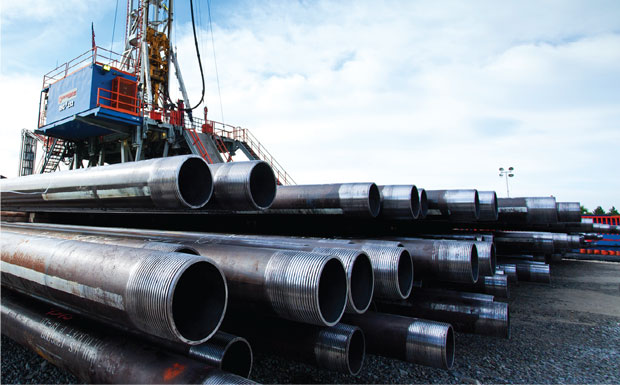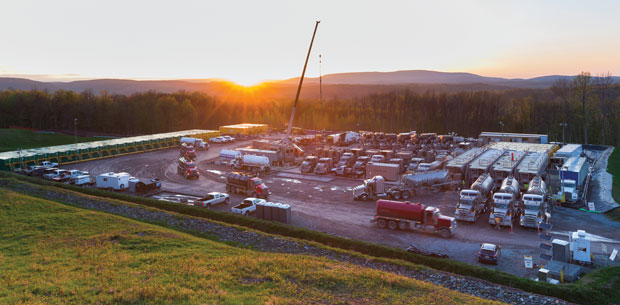
Appalachian Gas Producers Meet Regional Demand Growth, Prepare To Feed LNG Export Needs
By Danny Boyd, Special Correspondent
Appalachian Basin daily natural gas output has doubled during the past six years to top 35 billion cubic feet. Today, Appalachia by itself is outproducing all but two of the nations on the list of the world’s top liquified natural gas exporters in 2021: the United States and Russia. In short, Marcellus and Utica producers are sending more gas to the sales line every day than the entire countries of Australia, Qatar and Malaysia–all of which are among the five largest LNG exporters.
Marcellus and Utica producers have demonstrated time and again the prolific potential of Appalachian shale gas, regularly bringing on wells with initial production rates north of 20 million cubic feet a day. Now with global markets scrambling in the wake of Russia’s invasion of Ukraine, the Northeast region is positioned to carry the supply load for U.S. allies in Europe, Asia and all points in between with clean, responsibly sourced gas.
While the world waits and the industry pleads the case for more takeaway capacity, public super independents, powerful privately owned operators and a multitude of smaller Appalachian producers stand ready to further expand output and position prolific Marcellus-Utica gas shales to supply markets the world over.
As meteoric as Appalachian supply growth has been over the past decade, Toby Rice, chief executive officer at Pittsburgh-based EQT Corporation, the largest domestic gas producer, insists the sky is the limit if political leaders, regulators, consumers and allies recognize Appalachia’s potential and support the infrastructure build-out necessary to capture the massive recoverable reserves locked away in the Marcellus, Utica and Point Pleasant formations.
In fact, Rice says, Northeast production could double again to the 70 Bcf/d range in short order under the right set of market, regulatory and operating conditions. “We have a solution and that is specifically unleashing U.S. natural gas on the world stage, where we have said that we have the ability to increase LNG export capacity here in the United States an incremental 50 Bcf/d,” he says, noting that Appalachia would provide 35 Bcf/d of that total and other U.S. basins would account for the remaining 15 Bcf/d.
Unleashing U.S. LNG
Achieving 35 Bcf/d of new Appalachian production will require only 50 more active rigs and frac crews, Rice states. “Doubling Appalachian gas production to unleash U.S. LNG is entirely doable sooner rather than later,” he holds.
But fully unchaining the “Northeast supply beast” requires significant infrastructure additions on par with the level experienced between 2014 and 2020, when total pipeline takeaway capacity from the Northeast increased by 16.5 Bcf/d (including gas flows southward to the Gulf Coast, supporting record U.S. LNG exports). The capacity growth has come to a sudden halt over the past two years with cancellations of major projects, placing a ceiling on output growth.
To make it happen, major and accelerated investments in export terminals and pipelines are necessary in takeaway capacity-strapped Appalachia. A massive capacity expansion would be paid for entirely by the natural gas industry, costing taxpayers nothing, Rice points out.
The move under a more favorable political and regulatory environment would provide 50% surplus energy that would offer unprecedented energy security to American citizens even as geopolitical risks emerge in all corners of the world, Rice says.
Gas could be delivered to Europe for $10/MMBtu compared with more than $40/MMBtu today, he goes on. At the same time, American consumers would benefit by having clean, abundant, secure and affordable domestic natural gas frame the foundation of the U.S. economy. Increased supplies would keep U.S. storage full and domestic prices in the $4/MMBtu range while creating high-paying jobs and compelling benefits for all sectors of the economy.
EQT Corporation is America’s largest producer of natural gas, with all of its operations in the Appalachian Basin. EQT is proposing an “unleash U.S. LNG” strategy to increase domestic LNG export capacity by an incremental 50 Bcf/d, fed primarily by Appalachian production doubling to provide 35 Bcf/d of that total and other U.S. basins accounting for the remaining 15 Bcf/d.
The fortunes of U.S. manufacturers would get a boost from fuel prices 2.5 times lower than costs for competing international players, Rice says. Environmental benefits may include lowering global emissions by 1.5 billion tons annually as U.S.-produced natural gas displaces coal in power generation markets from western Europe to Southeast Asia.
“For our allies around the globe, an additional 50 Bcf/d of U.S. LNG exports on the world stage would be the equivalent of wiping Russian supply off the map two and a half times over,” he asserts. “Adding that amount of energy would bring tremendous stability and security to our allies and insulate us from the price shocks we see when geopolitical events happen around the world.”
A change starts with sentiment, and the environmentally friendly argument in favor of U.S. gas is resonating with some former industry opponents who are beginning to understand that blocking pipeline expansion means blocking energy security, lower prices and greater emissions reductions, Rice states.
He points out that regulatory proposals to establish a national methane emissions threshold of 0.2% compare with actual methane emissions of 0.05% in Appalachia as EQT and others eliminate pneumatic devices and take other measures to curb fugitive emissions sources.
“More than 80% of the energy used worldwide is hydrocarbon based, and as long as that is the case, we should be using the cleanest hydrocarbons. Nothing is as cleanly produced as gas from Appalachia shale,” Rice says.
Currently, the industry is going back to the table to identify changes in policies and regulations that will push projects forward, he reports. Reductions in red tape can speed approval and implementation from years to a matter of months.
According to Rice, EQT has the capability to significantly boost production from an inventory of 1.6 million acres, which includes 940,000 core acres with an inventory life of 18-plus years and another 700,000 acres that is economically attractive at gas prices north of $3/MMBtu.
“EQT has an investment-grade balance sheet that is going to help in structuring the long-term contracts, and we also have the best environmental score for our natural gas, which means it is going to be the most coveted natural gas on the world market,” he says.
Infrastructure Is Key
Range Resources Corporation is among the companies with the ability to move additional gas out of the basin when the time is right for it to shift from a maintenance strategy to production growth, says Chief Operating Officer Dennis Degner. Although total Appalachian output is nearing the upper limit of existing takeaway capacity, 1 Bcf/d-2 Bcf/d of combined demand and capacity is still available to Range.
“It goes without saying that infrastructure is key to the future of our industry and it is super critical as we think about getting our hydrocarbons to a world with strong energy demand,” Degner says. “Range is on the low end of the cost curve, we lead our peers from a capital efficiency standpoint, and we think we can deliver these hydrocarbons to customers and end-users in the most efficient manner. On top of that, the Marcellus is on the low end of the emissions curve globally.”
About 80% of Range Resources’ gross volume of 2 Bcf/d is shipped out of the basin, with about 50% flowing to the Gulf Coast through long-term transportation agreements, Degner explains. On the LNG side, 400 Mcf/d is exported through LNG outlets.
To maintain output, Range is bringing on approximately 60 wells this year, focusing on the Marcellus on a 460,000 net-acre stacked pay position in southwestern Pennsylvania also prospective of the Utica and Upper Devonian. Inventory includes 3,000 undrilled Marcellus wells, including 2,000 projected at 2 billion cubic feet equivalent or greater estimated ultimate recoveries per 1,000 foot of lateral.
Range Resources plans to drill 55 wells this year focused in the Marcellus on its 460,000 net-acre stacked pay position in southwestern Pennsylvania, which is also prospective of the Utica and Upper Devonian. The company has 3,000 undrilled Marcellus wells in its inventory, including 2,000 wells projected at 2 Bcfe or greater EURs per 1,000 foot of lateral, and the ability to target dry gas, wet gas, or a balance of both.
While some producers focus on either dry or wet gas, Range’s Washington County position provides a healthy balance, moving from pipeline-quality dry gas in the east to processable gas in the west that allows Range to generate approximately 100,000 barrels per day of natural gas liquids, making it a top 10 NGL producer in the country, Degner explains.
Creative drilling and well design teams now extend average lateral lengths beyond 11,000 feet, up by 5% in the second quarter compared with all of 2021, he points out. Range has drilled several wells with laterals longer than 18,000 feet and more than 50 with laterals extending beyond 15,000 feet.
Focusing on efficiencies, Range set an internal completions record of 11.3 stages a day in the second quarter, up from nine a day in the previous quarter. About 30%-50% of drilling involves moving back to existing pads. In the second quarter, the company returned for the third time to what is now a 12-well pad after drilling the first wells in 2011 and a second set in 2018, Degner elaborates.
The company also continues to curb emissions, making key strides toward net zero Scope 1 and Scope 2 GHG emissions by 2025. In fact, based on third-party data, Range Resources ranks lowest in carbon dioxide emissions intensity among peers. The company also certified four well pads through Project Canary’s TrustWell™ process. Range uses an electric frac fleet, is entering a pilot program for instrument air for pneumatic controllers and maintains a robust leak detection and repair program, which conducts quarterly inspections at production sites but is increasing the frequency to eight times a year in 2022, Degner notes.
“Emissions from development activities have been reduced 31%, and since 2018, our Scope 1 emissions have been reduced 58% and methane intensity has dropped 75% while production has remained relatively constant,” Degner reports.
While production is steady, Range has the capability to ratably increase NGL output, Degner says. Currently, the company extracts 60,000-65,000 bbl/d of ethane from gas, partly to keep gas in line with pipeline requirements, but has the ability to capture an additional 15,000-20,000 bbl/d as domestic and foreign demand rises.
“Demand for energy is growing and changing, and the one thing that is pretty apparent is that natural gas is going to play a critical, expanded role in the coming years,” Degner remarks. “If that is the case, and we believe it surely will be, then look no further than the Appalachian Basin for responsibly sourced gas that can meet emissions requirements and expectations for quantity.”
High-Quality Position
The acquisition in March of Chief Oil & Gas, including 113,000 net Marcellus acres, gives Chesapeake Energy Corporation additional flexibility to further coordinate development with outflow instead of having to compete with another company for space on the same pipelines transporting gas out of northeastern Pennsylvania, says Chief Operating Officer Josh Viets. The addition also gives Chesapeake increased exposure to higher out-of-basin pricing, he says.
“Being the single owner gives us the opportunity to not only plan our development programs to the point that we drill wells that we know have capacity for, but also provides a single voice to work with our midstream providers to help them better plan their business and time their investments,” Viets details.
Chesapeake times drilling and development of 80-95 wells a year across its inventory of 1,435 wells on available off-take from 650,000 net acres in northeastern Pennsylvania to avoid backing out base production as it boosts output, he explains.
Overall lateral lengths, which today average a little more than 10,000 feet at a cost of $750-$850 per lateral foot, are expected to grow slightly going forward, he details. On the completion side, proppant loading ranges from 1,500 pounds/lateral foot in better rock to more than 3,000 pounds in some areas of the Upper Marcellus, with stage lengths varying from 150 to 350 feet with five to seven clusters per stage.
In addition to continuing to realize strong results in the Lower Marcellus, the company’s technical team and its prowess at customizing frac designs to optimize results is reaping benefits in the Upper Marcellus, Viets points out.
Chesapeake Energy’s LINSKI 25HCat well in southeastern Bradford County, Pa., came on line producing almost 44 MMcf/d from the Upper Marcellus. A three-well development produced at peak rates of 50 MMcf/d-60 MMcf/d on a gross basis, and the three wells cumulatively produced roughly 5 Bcf apiece over their first five months.
The LINSKI 25HCat well in southeastern Bradford County, Pa., produced almost 44 MMcf/d from the Upper Marcellus, a result that also demonstrates the company’s premier acreage position, he says. A three-well development produced at peak rates of 50 MMcf/d-60 MMcf/d on a gross basis, Viets reports. Over the first five months, the wells cumulatively produced roughly 5 Bcf apiece.
“That speaks to not just the quality of the wells that get drilled in the Marcellus, but specifically to the quality of the acreage position that Chesapeake has and to the runway we have for developing the Lower Marcellus and Upper Marcellus going forward,” he says.
Despite Chesapeake’s attractive position and results, Viets says overall takeaway constraints in Appalachia are punishing American consumers as much as international customers.
“It is unfortunate because Appalachia includes some of the lowest break-even gas available in North America with some of the best shale rock anywhere on the globe,” Viets comments.
Supplying regional needs, including additional power generation and other industries, should give producers additional in-basin outlets for their gas, Viets says, while regulatory and legal hurdles hinder development of takeaway capacity expansions.
“As a country, from the federal level down to the states and local communities, we must find a way to come together if we are serious about solving a global energy crisis and want to see the Marcellus unlocked,” Viets states.
He points to Appalachia’s superior emissions performance as a compelling argument supporting expanded production. In the Marcellus, 100% of legacy Chesapeake gas is certificated as responsibly sourced with results including an A grade from MiQ and a pass grade on a pass-fail system from Equitable Origins.
Fixed devices on 80% of legacy production and all new well pads continuously monitor emissions. The company also is partnering with Bridger Photonics to do flyovers multiple times a year, beginning in August, to help better detect and assess potential leaks, Viets says.
Superior assets, combined with a strong capital return framework, position Chesapeake to be successful now and into the future, he stresses.
“We believe the world is going to need more energy and we see ourselves continuing to raise the bar and meet the demands of society by providing more reliable, affordable, lower-carbon energy,” Viets says.
Stacked Pay Potential
Olympus Energy LLC continues to tap into the Marcellus and look to further develop the Utica beneath it in southwestern Pennsylvania to supply the region with energy that benefits consumers and reduces emissions, says COO Michael Wahl.
Development of the Marcellus has already had huge benefits on Appalachia consumers and industrial markets, Wahl points out. For example, ongoing gas cost savings for each Pennsylvania household over the past decade is equivalent to one-time COVID relief checks during the height of the pandemic, he says, and roughly two-thirds of regional emissions reductions stem from switching from coal to natural gas as boiler fuel.
Rebranded from Huntley & Huntley Energy Exploration in 2019, Olympus is expanding production on a position that includes 100,000 acres in the heart of the Marcellus and Utica fairways in southwestern Pennsylvania as it keeps an eye out for bolt-on opportunities with synergies, Wahl says.
Stacked pay potential allows the company to optimize pad utilization on the same area of surface disturbance and take advantage of existing pipeline capacity, he says.
Olympus Energy is running two rigs with plans to significantly increase its well count this year. The company is expanding production on a position that includes 100,000 acres in the heart of the Marcellus and Utica fairways in southwestern Pennsylvania, and it is keeping an eye out for bolt-on acreage acquisition opportunities near its core stacked pay leasehold.
“The Marcellus on its own is one of the most efficient energy sources out there in terms of energy produced per acreage of surface disturbance, and it is that much better when you add stacked pay potential to it,” Wahl remarks. “The deep Utica is underdeveloped right now, but it is a world-class resource. We sit atop some of the best rock in the world in the deep, dry Utica beneath what is already core Marcellus fairway. The Utica is going to be a big play moving forward.”
Running two rigs, the company has significantly boosted its well count this year with more wells planned and completions slated for drilled but not completed wells in inventory, he says.
The operator of the longest horizontal well drilled in Pennsylvania (lateral length of more than 20,000 feet), Olympus is committed to long-lateral development, Wahl says, to reduce its surface footprint further and improve operational efficiency through a team that excels at job preplanning and operational execution.
The private company does not divulge completion details, but is committed to leading-edge designs, Wahl offers. Olympus currently is running a dedicated electric frac fleet, he says.
“When you think about the electric frac fleet market, most of them are dedicated to bigger players than Olympus,” Wahl points out. “It is something we believe is a differentiator and helps us be the best neighbor we can be.”
Project Canary has certified all of Olympus’ natural gas output, Wahl adds. Moreover, Olympus has not trucked any freshwater for completions in three years. Instead the company has invested in developing its own freshwater infrastructure, including three freshwater withdrawals, in cooperation with its wholly owned subsidiary, Hyperion Midstream LLC. Alignment with Hyperion helps time infrastructure build-out of gathering lines, too, and results in better margins for gas, he says. Olympus is also undergoing the RSG certification of its midstream operations and expects that process to be completed by year-end, he says.
“To be a leader in this space, it is important to make sure that the ‘how’ of what we do is weighted just as heavily as the ‘what’ of what we do. The natural gas we produce is a very important supply source for the country and beyond in terms of expanded LNG exports going forward,” Wahl says.
Regional pipeline takeaway capacity will benefit from the completion of the 303-mile Mountain Valley Pipeline project, and the Marcus Hook and Cove Point LNG terminals certainly help, but substantially more takeaway is needed before Appalachia is elevated from a regional player to a global powerhouse, he says.
“Appalachia’s high-quality shale rock and low emissions intensity give the region the potential to become a major global gas supplier if takeaway capacity and LNG export capacity can catch up to output potential, Wahl concludes.
For other great articles about exploration, drilling, completions and production, subscribe to The American Oil & Gas Reporter and bookmark www.aogr.com.










